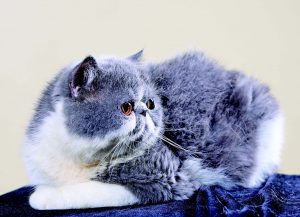‘Tis the season of short hair, what with women finally chopping their long locks and proudly flaunting bobs and pixie cuts! Apparently, this trend isn’t exclusive to humans, what with Exotic Shorthairs fast becoming a favorite.
The fascination is understandable. An Exotic Shorthair is the best of both worlds: you get to enjoy the company of a Persian, sans the issues that come with long hair.
Interview with breeder Mannix Chua
Q: Why is an Exotic Shorthair sometimes called a “Persian in a petticoat”?
Mannix Chua (MC): I think it’s because it can be described as a short-haired Persian. They have [a] medium-length coat that is dense and plush with a thick undercoat, as opposed to the Persian’s long coat.They are sometimes called the “lazy man’s Persian.”
They are bred to be just like the Persian, except with a short, dense coat instead of a long, flowing one.
Q: Can you give us a brief history of the Exotic Shorthair?

MC: The Exotic is something of an accidental breed. The original intent of the American Shorthair breeders who got the ball rolling was to breed their cats to Persians in an effort to bring in the silver color and green eyes of that breed. The resulting kittens didn’t look like American Shorthairs, but they were very attractive, having the Persian look but with a short, plush coat. Other breeders brought in Burmese or Russian Blues to get the gene for the short coat. The various offspring were bred back to Persians. The eventual result was a cat with the same features and personality as the Persian but wrapped in a short, plush, easy-care coat. Thus a new breed was born: the Exotic Shorthair, or just Exotic.
The Cat Fanciers Association recognized the breed in 1967 and called it the Exotic. In some other associations, it’s known as the Exotic Shorthair to differentiate it from the Exotic Longhairs that sometimes appear in Exotic litters and are considered by some associations as a breed unto themselves. The International Cat Association recognized the breed as the Exotic Shorthair in 1979. Today Exotics are recognized by all cat registries. Exotics these days are outcrossed only to Persians and Himalayans, not to any shorthaired breeds. (Source: http://cattime.com)
Q: How vocal and affectionate are they?
MC: Males tend to be more affectionate. They do well in homes with children who can treat them nicely. They also get along with other pets.
Q: What are The International Cat Association (TICA) standards for the Exotic?
MC: The Exotic Shorthair is the shorthair equivalent of the Persian and Himalayan breeds and is differentiated from the Persian and Himalayan by coat length only. It is accepted in all colors. Its plush, dense coat and similar type give the breed a teddy bear-like appearance.
Exotic Shorthairs’ coats should be short, but slightly longer than other shorthairs. Soft, dense, plush; standing away from body.
Q: How would you describe its temperament and personality?
MC: The Exotic is a peaceful, easy going companion who will be content to quietly follow you around and then sit in your lap for petting whenever you give them the chance. They are also sweet, docile, and quiet.
Q: Is it easy to groom Exotic Shorthairs without professional help?
MC: Yes. Their short coat does not mat or tangle. Comb them once or twice a week with a stainless steel comb to keep their coats beautiful.
Q: Are they expensive to keep?
MC: They are not overly expensive to keep but also not cheap. You have to think of the food, vet visits, toys, cat litter sand, and other essential needs to make them happy.
Q: What needs do they have that may need special care?
MC: Extra attention should be given to their eye care. They often have eye leakage because of their short noses. Luckily, most eye leakage is harmless and just a cosmetic concern [and you can simply] wipe the corners of the eyes daily to prevent under-eye stains from forming. But if not treated properly, this increase in eye drainage can cause infections and other eye issues.
Because Exotic shorthairs have extremely short noses, respiratory problems are also a common concern.
Q: What factors should one consider for adoption? Is it difficult to find an Exotic in the Philippines? How does one ensure that a cat comes from ethical breeders?
MC: When adopting an Exotic Shorthair, there are lots of things to consider. One is their health: [they] should be playful and lively. Another is age. [A kitten should be at least] nine weeks old.
One other thing is its temperament. Some tend to be feisty, but generally, they are calm and sweet. Other [factors to consider include] their physical features: face, eyes, ears, coat, color, and body.
Nowadays, there are many importers and breeders of Exotic Shorthairs in the Philippines. Look for reputable breeders; do some research and some background checks.
Q: How can a potential owner tell if an Exotic Shorthair for adoption is healthy?
MC: [An Exotic] should be playful and attentive. Eyes should be clear, not closed. The weight of a kitten should not be on the low side. Its coat should be full, with no bald spots.
Q: What factors should one consider before deciding to get an Exotic?
MC: [One should have the] time to care and interact with them. And of course, [think of] the financial aspect also for their food, vet bills, and other needs.
Q: Aside from providing their needs, how else does one care for this breed so that they live a long and happy life?
MC: Give them lots of love and care. Play and interact with them regularly. Have regular visits with their vet.
This appeared in Animal Scene magazine’s January 2018 issue.







